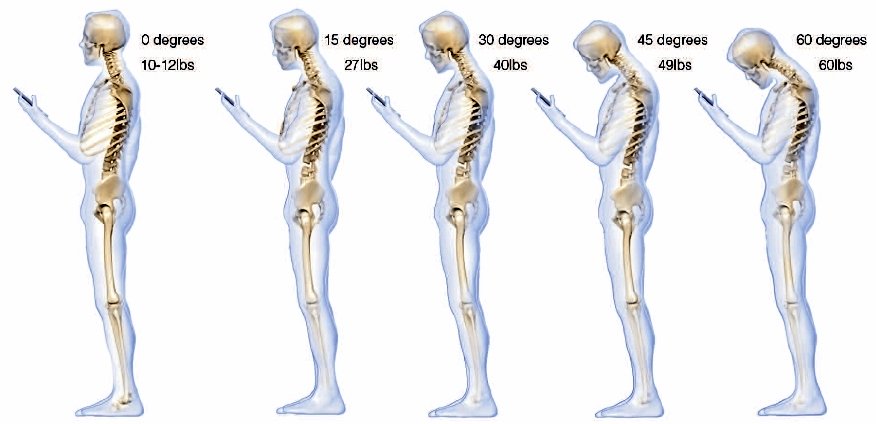Constantly looking down at your phone can cause a 27kg force on your neck
Tech neck trouble: Constant phone use may be the culprit
In today’s digital age, it’s no secret that children and adolescents are spending more and more time on their smartphones, tablets, and other handheld devices. While these technologies have their benefits in offering convenience and connectivity, there is a growing concern about the negative health effects that come with prolonged use. One such concern is the development of Text Neck Syndrome.
Text Neck Syndrome is a condition characterized by neck and upper back pain that results from hunching over smartphones and other devices. This condition is becoming increasingly prevalent among younger populations, and it’s important to raise awareness about its causes, symptoms, and preventative measures.
When we constantly look down at our phones, we put an immense amount of pressure on our necks. In fact, research suggests that the weight of the head can increase up to 27kg as it bends forward at a 60-degree angle. This extra stress on our cervical spines can lead to pain, discomfort, and long-term damage.

To address Text Neck Syndrome, it’s important to understand its causes. One of the primary causes is poor posture. When we hunch over our devices, we put our necks and upper backs in an unnatural position, straining the muscles and ligaments in these areas. Additionally, the repetitive motion of constantly looking down at our phones can lead to muscle imbalance and weakness.
Recognizing the symptoms of Text Neck Syndrome is crucial for early intervention. These symptoms may include neck and upper back pain, stiffness, headaches, and even radiating pain down the arms. If left untreated, Text Neck Syndrome can worsen over time and impact daily activities.
Fortunately, there are preventative measures that can be taken to reduce the risk of developing Text Neck Syndrome. First and foremost, it’s important to practice good posture. Sit up straight, keep your shoulders back, and hold your phone or device at eye level to minimize strain on your neck. Taking regular breaks from device use can also help alleviate stress on your neck and upper back.
At All Well Holistic Health, we are committed to helping you maintain a pain-free and healthy future. We specialize in holistic approaches to wellness, and we offer personalized solutions to address the root causes of Text Neck Syndrome. Your health is in your hands, and we’re here to support you on your journey to recovery.
Remember, your health is in your hands, and taking care of your neck and upper back is essential for a pain-free and healthy future.
If you have any questions or concerns, please don’t hesitate to reach out to us. Your well-being is our top priority.
References:
David D, Giannini C, Chiarelli F, Mohn A. Text neck syndrome in Children and Adolescents. Int J Environ Res Public Health. 2021 Feb 7; 18(4):1565.doi: 10.3390/ijerph18041565.PMID:33562204; PMCID:PMC7914771
Tsantili AR, Chrysikos D, Troupis T. Text Neck Syndrome: Disentangling a New Epidemic. Acta Med Acad. 2022 Aug;51(2):123-127. doi:10.5644/ama2006-124.380.PMID:36318004; PMCID:PMC9982850
Chu E, Mok T, NG G et al. Pediatric Text Neck Syndrome. Cureus. 2023 Apr 23; 15(4):e38034.doi:10.7759/cureus.38034
Kumari S, Kumar R, Sharma D.. Text neck syndrome: The pain of modern era. Journal of Health Sciences & Research. 11 (11).161-165. doi: https://doid.org/10.52403/ijhsr.20211121
Neupane S, Ali U TI, Matthew A, & College M VS. Text neck syndrome – Syustematic Review. Imperial Journal of Interdisciplinary Research. 2017; 7, 141-148
